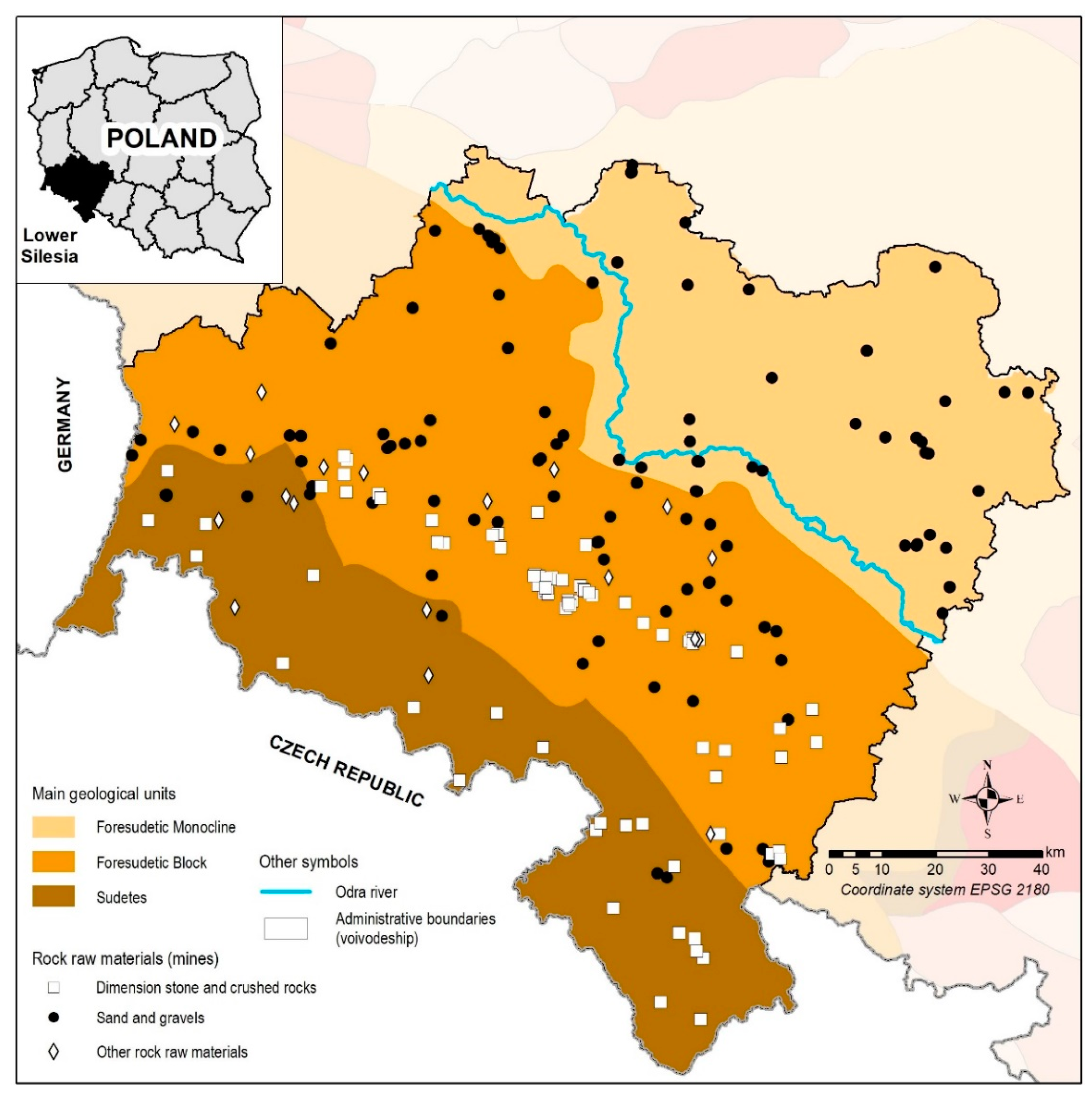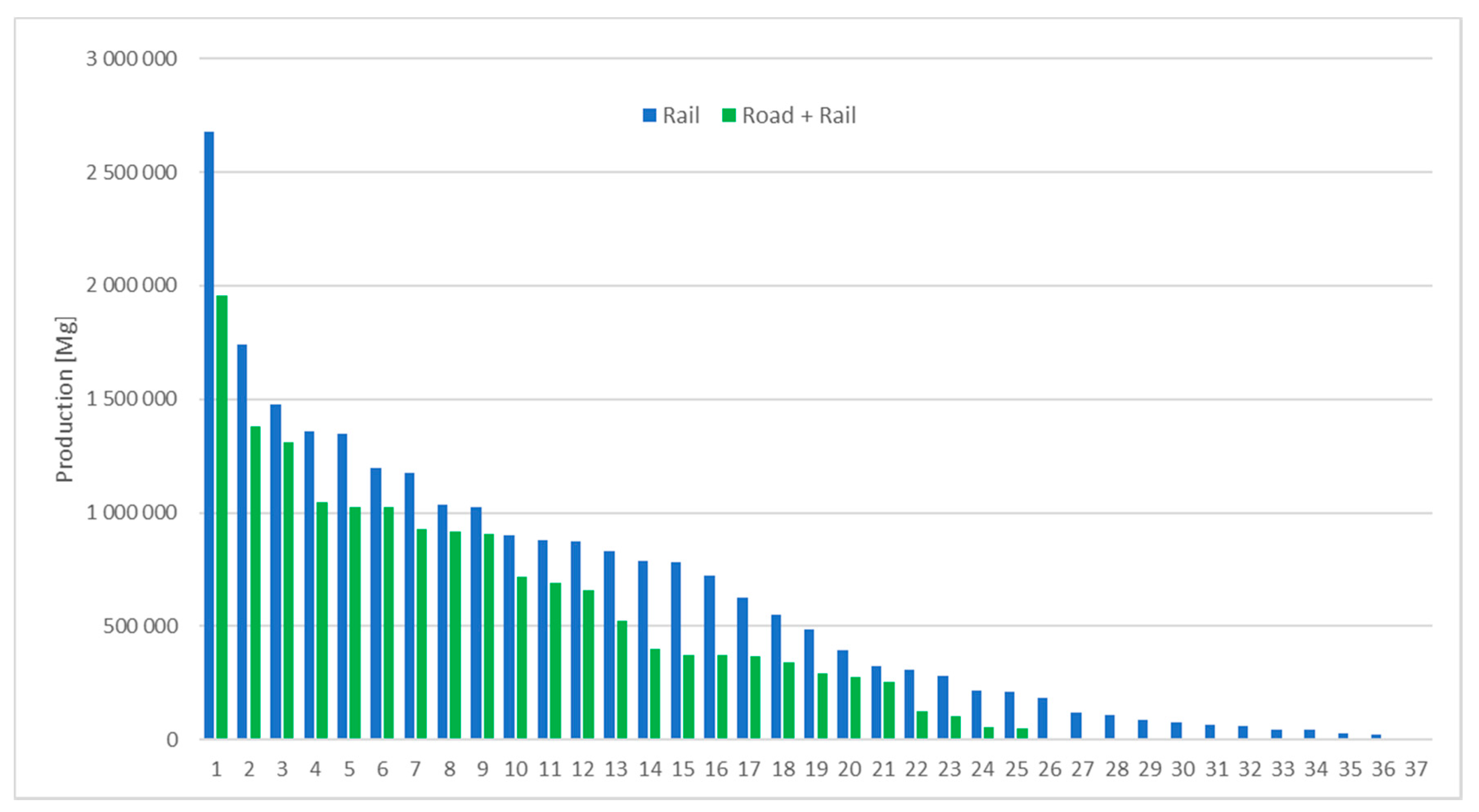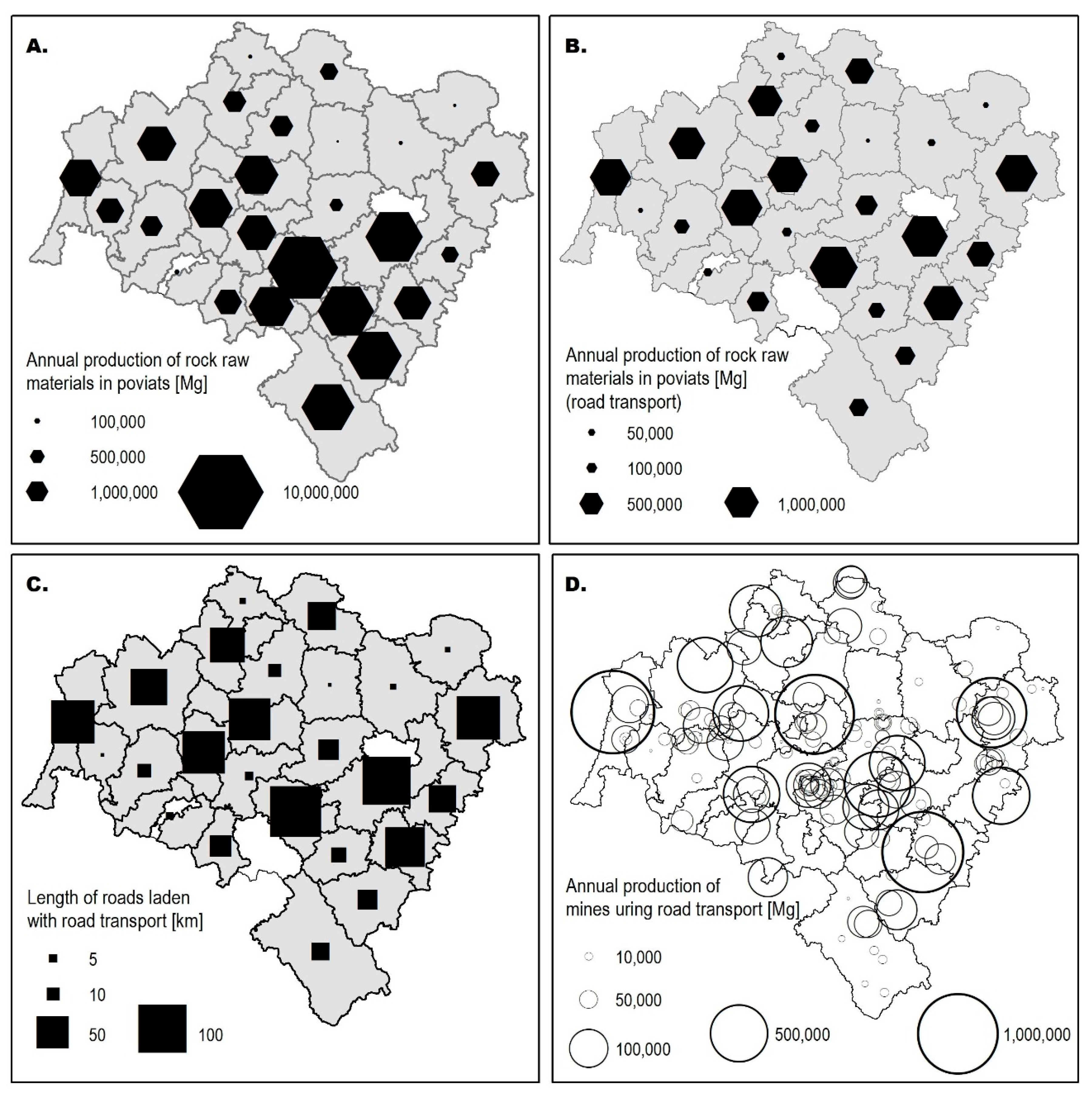Analysis of Rock Raw Materials Transport and its Implications for Regional Development and Planning. Case Study of Lower Silesia (Poland)
Abstract
1. Introduction
2. Description of Study Area
2.1. Geology and Mining of Rock Raw Materials
2.2. Railway Infrastructure
3. Materials and Methods
4. Results and Discussion
4.1. Analysis of Rock Raw Material Transport
4.2. Analysis of Conditions Suitable for Rail Transport of Rock Raw Materials
4.3. Analysis of the Potential for Railway Transport of Rock Raw Materials
5. Conclusions
Author Contributions
Funding
Acknowledgments
Conflicts of Interest
References
- Brown, T.J.; Idoine, N.E.; Raycraft, E.R.; Hobbs, S.F.; Shaw, R.A.; Everett, P.; Kresse, C.; Deady, E.A.; Bide, T. World Mineral Production 2013-17; British Geological Survey: Nottingham, UK, 2019. [Google Scholar]
- Gawlik, L.; Kryzia, D.; Uberman, R. Costs of railway and road transport in the context of rock materials market balancing in Poland. Sci. Pap. Inst. Min. Eng. Wroc. Univ. Sci. Technol. 2013, 136, 21–35, (In Polish with English summary). [Google Scholar]
- Kryzia, D.; Kopacz, M. The analysis of the conditions and transport costs of gravel and sand aggregates by rail and by heavy trucks in Poland. Logistics 2014, 4, 4573–4583, (In Polish with English Summary). [Google Scholar]
- Nowakowski, T.; Kwaśniowski, S.; Zając, M. Logistics problems of rock yield carriage in Lower Silesia region in face of co-modality. Logistics 2013, 4, 2010, (In Polish with English summary). [Google Scholar]
- Chęciński, S. Rock raw materials haulage routes modelling with GIS environment. Min. Sci. Miner. Aggreg. 2014, 21, 27–35, (In Polish with English summary). [Google Scholar]
- Beuthe, M.; Jourquin, B.; Geerts, J.F.; à Ndjang’Ha, C.K. Freight transportation demand elasticities: A geographic multimodal transportation network analysis. Transp. Res. Part E 2001, 31, 253–266. [Google Scholar] [CrossRef]
- Łochańska, D.; Stryszewski, M. Logistics considerations as for satisfying a demand for rock raw material depending on its kind, quality as well as optimisation of roads and resources. Górnictwo Odkryw. Open Cast Min. 2011, 6, 96–99, (In Polish with English summary). [Google Scholar]
- Stryszewski, M.; Łochańska, D. Transport as a regionalisation factor of rock raw materials mining production. Górnictwo Odkryw. Open Cast Min. 2013, 5, 146–150, (In Polish with English summary). [Google Scholar]
- Blachowski, J. Spatial analysis of the mining and transport of rock minerals (aggregates) in the context of regional development. Environ. Earth Sci. 2014, 71, 1327–1338. [Google Scholar] [CrossRef]
- Kendall, A.; Kesler, S.E.; Keoleian, G.A. Megaquarry versus decentralized mineral production: Network analysis of cement production in the Great Lakes region, USA. J. Transp. Geogr. 2010, 18, 322–330. [Google Scholar] [CrossRef]
- Andrés, L.; Padilla, E. Energy intensity in road freight transport of heavy goods vehicles in Spain. Energy Policy 2015, 85, 309–321. [Google Scholar] [CrossRef]
- Robinson, G.R.; Kapo, K.E. A GIS analysis of suitability for construction aggregate recycling sites using regional transportation network and population density features. Resour. Conserv. Recycl. 2004, 42, 351–365. [Google Scholar] [CrossRef]
- Hill, M.P. Aggregate opportunity modelling: Understanding our resource and planning for the future. In Proceedings of the AusIMM NZ Branch Conference 2018, Tauranga, New Zealand, 17–18 September 2018. [Google Scholar]
- Central Statistical Office. Local Data Bank. Available online: www.stat.gov.pl (accessed on 16 January 2020).
- Oberc, J. Geological Structure of Poland, 2nd ed.; Geological Publishing House: Warsaw, Poland, 1972. (In Polish) [Google Scholar]
- Stupnicka, J. Regional Geology of Poland, 3rd ed.; Warsaw University Press: Warsaw, Poland, 2007. (In Polish) [Google Scholar]
- Koźma, J. Mineral resources—State and potential for development. In Ecophysiographical Study of the Lower Silesia Voivodeship, 2nd ed.; Lower Silesia Marshal Office: Wroclaw, Poland, 2005. (In Polish) [Google Scholar]
- Polish Geological Institute. Balance of the Mineral Resources and Underground Waters of Poland. 2019. Available online: http://geoportal.pgi.gov.pl/surowce (accessed on 11 February 2020).
- Osika, R. Geology and Mineral Resources of Poland, 2nd ed.; Geological Publishing Office: Warsaw, Poland, 1970. (In Polish)
- Office of Rail Transport. Railways in Voivodeships—Use and Transport Policy. 2019. Available online: https://utk.gov.pl/ (accessed on 31 January 2020).
- Zakęś, A. Railway Network in the Lower Silesia Region; Lower Silesia Marshal Office: Wrocław, Poland. Unpublished. (In Polish)
- Office of Rail Transport. Railways in Voivodships—Dynamics of Changes. 2017. Available online: https://utk.gov.pl/pl/dokumenty-i-formularze/opracowania-urzedu-tran/15443,Kolej-w-wojewodztwach-wykorzystanie-i-polityka-transportowa.html (accessed on 31 January 2020).
- Office of Rail Transport. Statistics of Freight Transport 2000–2018. Available online: https://utk.gov.pl/pl/aktualnosci/ (accessed on 31 January 2020).
- Office of Rail Transport. Transport of Freight Groups in 2018. Available online: https://utk.gov.pl/pl/dokumenty-i-formularze/opracowania-urzedu-tran (accessed on 31 January 2020).
- French, R.R. Transportation of Mineral Aggregates in Indiana. Proc. Indiana Acad. Sci. 1968, 7, 348–354. [Google Scholar]







| Road | Road + Rail | Road | |
|---|---|---|---|
| Max. production | 2,676,000 | 1,958,000 | 1,053,000 |
| Min. production | 20,000 | 40,000 | 1000 |
| Mean production | 639,731 | 620,230 | 110,035 |
| Q1 (75%, 25%) | 117,250 | 280,250 | 12,000 |
| Q2 (Median) | 518,500 | 462,500 | 35,000 |
| Q3 (25%, 75%) | 930,250 | 926,500 | 132,750 |
| Road | Road + Rail | Road | ||
|---|---|---|---|---|
| Dimension stones and crushed rocks | Max. production | 2,676,000 | 1,958,000 | 330,000 |
| Min. production | 20,000 | 40,000 | 1000 | |
| Mean production | 734,154 | 689,700 | 63,132 | |
| Q1 (75%, 25%) | 211,000 | 329,750 | 7000 | |
| Q2 (Median) | 587,000 | 674,000 | 23,000 | |
| Q3 (25%, 75%) | 1,139,750 | 1,024,250 | 64,750 | |
| Sands and gravels | Max. production | 788,000 | 929,000 | 1,053,000 |
| Min. production | 60,000 | 101,000 | 1000 | |
| Mean production | 372,200 | 388,667 | 117,894 | |
| Q1 (75%, 25%) | 106,000 | 258,250 | 15,000 | |
| Q2 (Median) | 184,000 | 324,500 | 34,000 | |
| Q3 (25%, 75%) | 723,000 | 393,750 | 135,750 | |
| Other rock raw materials | Max. production | 871,000 | - | 496,000 |
| Min. production | 28,920 | - | 1000 | |
| Mean production | 416,266 | - | 116,858 | |
| Q1 (75%, 25%) | 42,560 | - | 39,075 | |
| Q2 (Median) | 309,500 | - | 89,000 | |
| Q3 (25%, 75%) | 829,350 | - | 197,455 |
| Road Distance [km] | Straight Line Distance [km] | |
|---|---|---|
| Max. production | 30.2 | 19.3 |
| Min. production | 2.1 | 1.6 |
| Mean production | 8.68 | 5.94 |
| Q1 (75%, 25%) | 8.0 | 5.4 |
| Q2 (Median) | 6.0 | 3.0 |
| Q3 (25%, 75%) | 9.3 | 7.7 |
| Criterion 1 [km] | Criterion 2 [Mg] | Criterion 3 [Mg] | Criterion 4 [-] | Score |
|---|---|---|---|---|
| <6.0 | >900,000 | >5,000,000 | Rock raw materials key for national economy (crushed rocks and other) | 3 |
| 6.0–8.0 | 450,001–900,000 | 2,000,001–5,000,000 | Other crushed rocks | 2 |
| 8.1–9.5 | 100,000–450,000 | 5,000,001–2,000,000 | Sands and gravels | 1 |
| >9.5 | <100,000 | <500,000 | Dimension stones, other | 0 |
| No | Mine | Score C1 | Score C2 | Score C3 | Score C4 | Final Score Scenario A | Final Score Scenario B |
|---|---|---|---|---|---|---|---|
| 1. | o | 3 | 3 | 3 | 1 | 2.5 | 2.8 |
| 2. | y | 3 | 3 | 3 | 1 | 2.5 | 2.8 |
| 3. | x | 3 | 2 | 3 | 1 | 2.25 | 2.5 |
| 4. | h | 3 | 1 | 3 | 3 | 2.5 | 2.4 |
| 5. | c | 3 | 1 | 3 | 2 | 2.25 | 2.3 |
| 6. | d | 3 | 1 | 3 | 2 | 2.25 | 2.3 |
| 7. | f | 3 | 1 | 3 | 2 | 2.25 | 2.3 |
| 8. | g | 3 | 1 | 3 | 2 | 2.25 | 2.3 |
| 9. | q | 3 | 2 | 2 | 1 | 2 | 2.3 |
| 10. | t | 3 | 2 | 2 | 1 | 2 | 2.3 |
| 11. | u | 3 | 2 | 2 | 1 | 2 | 2.3 |
| 12. | e | 3 | 1 | 2 | 3 | 2.25 | 2.2 |
| 13. | b | 3 | 1 | 3 | 1 | 2 | 2.2 |
| 14. | p | 3 | 1 | 3 | 1 | 2 | 2.2 |
| 15. | k | 3 | 1 | 2 | 2 | 2 | 2.1 |
| 16. | n | 2 | 2 | 3 | 1 | 2 | 2.1 |
| 17. | l | 3 | 1 | 2 | 1 | 1.75 | 2 |
| 18. | r | 3 | 1 | 2 | 1 | 1.75 | 2 |
| 19. | s | 3 | 1 | 2 | 1 | 1.75 | 2 |
| 20. | v | 3 | 1 | 2 | 1 | 1.75 | 2 |
| 21. | a | 2 | 1 | 3 | 1 | 1.75 | 1.8 |
| 22. | j | 1 | 1 | 3 | 3 | 2 | 1.6 |
| 23. | i | 2 | 1 | 2 | 1 | 1.5 | 1.6 |
| 24. | m | 2 | 1 | 2 | 1 | 1.5 | 1.6 |
© 2020 by the authors. Licensee MDPI, Basel, Switzerland. This article is an open access article distributed under the terms and conditions of the Creative Commons Attribution (CC BY) license (http://creativecommons.org/licenses/by/4.0/).
Share and Cite
Blachowski, J.; Buczyńska, A. Analysis of Rock Raw Materials Transport and its Implications for Regional Development and Planning. Case Study of Lower Silesia (Poland). Sustainability 2020, 12, 3165. https://doi.org/10.3390/su12083165
Blachowski J, Buczyńska A. Analysis of Rock Raw Materials Transport and its Implications for Regional Development and Planning. Case Study of Lower Silesia (Poland). Sustainability. 2020; 12(8):3165. https://doi.org/10.3390/su12083165
Chicago/Turabian StyleBlachowski, Jan, and Anna Buczyńska. 2020. "Analysis of Rock Raw Materials Transport and its Implications for Regional Development and Planning. Case Study of Lower Silesia (Poland)" Sustainability 12, no. 8: 3165. https://doi.org/10.3390/su12083165
APA StyleBlachowski, J., & Buczyńska, A. (2020). Analysis of Rock Raw Materials Transport and its Implications for Regional Development and Planning. Case Study of Lower Silesia (Poland). Sustainability, 12(8), 3165. https://doi.org/10.3390/su12083165






